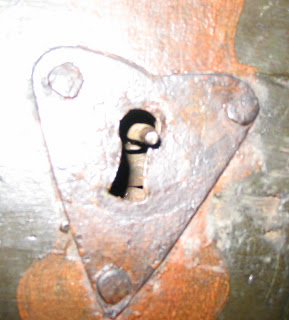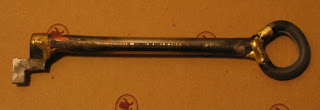23/07/08 18:00 Filed in:
Technology | Home
The njerd goes retro.
Recently, my mother-in-law died and left us an old Norwegian immigrant chest but no key. The chest was about 4 feet long, 2 feet wide and 2 feet high made of wood about 1 inch thick. It was very heavy and we joked that there might be a body inside.
The chest was dated 1792 and had an old fashioned lock that apparently used a large key with a 1/2 inch diameter hollow key. We talked to a number of locksmiths who claimed they could open the chest but not guarantee they would not damage the chest. I told them that I could certainly do just as well and took the challenge. We located a blacksmith associated with the
Vesterheim Norwegian-American Museum
in Decorah, IA who had opened similar chests for them. He was willing to come to Minneapolis sometime next month at a cost of $500, but was kind enough to explain to me what his process to make a key. It took me a couple of days, about 6 hours and 6 trips back and forth between my shop and the chest, but I accomplished the task. As I was working on this, I thought of the Norwegian carpenter/blacksmith who built this chest over 200 years ago and who had used it in the passing years.
I started with an old door
|

hinge from which I cut one of the three rolled parts with part of the flat portions. It actually took me a couple attempts to get a piece the right length to use as a primary blank. I braised a piece of copper water pipe to the hinge blank and a steel ring bolt to the other end. To get the right lengths inside the lock, I used a bent paper clip to probe the depth of the lock and internal parts. The lock was almost 2 inches deep though the first inch was just to get past the wooden side of the chest. The lock was a basic "
warded lock
" with one ward requiring that I had to cut the key blank to allow rotation. I determined the location of the ward by dripping candle wax on the key and turning it to get an impression of the ward on the key. The ward seemed to be tapered since it took me about 4 attempts as I kept cutting more and more of my key blank away. By that time, I had my Dremel tool with me to make fine adjustments on site with the chest.
As you can see from the final version of the key, I ended up cutting most of the blank away. It was a great feeling when the key finally turned in the lock and I raised the lid. Unfortunately, there was no great treasure inside, just heavy metal tools and some old clothes. A 1977 newspaper lined the chest, giving the best guess of when it was last opened.






